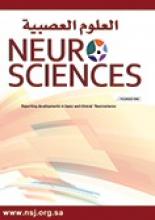Abstract
OBJECTIVE: This study was undertaken to detect the course of Bell’s phenomenon development in full and pre-term babies.
METHODS: Three hundred healthy newborns (150 full term and 150 pre-term) born at Prince Rashid Bin Al-Hasan military hospital from the first of January 2000 to 31st of December 2000 in Irbid in the north of Jordan, were randomly selected and included in the study. Bell’s phenomenon response was graded according to the movement of the eye as: 0 = no movement, 1 = minimal movement (the pupil still visible), 2 = full movement (the pupil is covered by the eyelid). The Bell’s Phenomenon Scoring System (BPSS) was chosen to score the eye movement. The newborn was examined during the first week of life and then repeated at 4 weekly intervals, for 5 months for the full term babies and for 2 months for the pre-term babies.
RESULTS: In the full term group only 25/150 (16.7%) of the newborns showed full response (BPSS-2) during the first week of life and this number increased to 133/150 (88.7%) at the age of 5 months. None of the pre-term group showed the Bell’s phenomenon response (BPSS-0) during the first week of life and only 21/150 (14%) had full response (BPSS-2) at 4 weeks. At the age of 2 months approximately 51/150 (34%) developed full response (BPSS-2).
CONCLUSION: The development of Bell’s phenomenon reflex reflects the maturation process of the brainstem and the extraocular muscles related to eye elevation. It should be considered as part of the routine tests undertaken by every pediatrician and ophthalmologist during the neuro-ophthalmic examination in newborns.
- Copyright: © Neurosciences
Neurosciences is an Open Access journal and articles published are distributed under the terms of the Creative Commons Attribution-NonCommercial License (CC BY-NC). Readers may copy, distribute, and display the work for non-commercial purposes with the proper citation of the original work.






